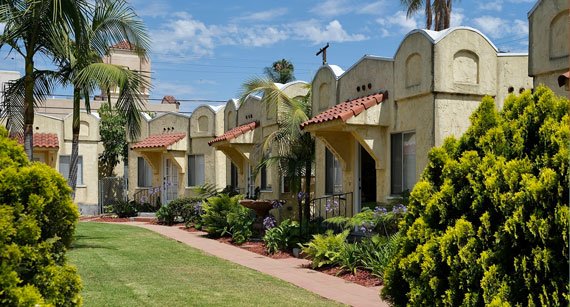|
San Diego’s Missing Link: Naturally Occurring Affordable Housing
By Bruce Coons
SOHO Executive Director
July/August 2023
 Image of one side of a bungalow court, 30th Street, North Park. Photo by TMVisser
In 2022, the San Diego Housing Commission released their report titled “Preserving Affordable Housing in the City of San Diego.” The introduction explains that. “Preserving existing affordable rental housing units in the City of San Diego is an essential element of a balanced approach that combines preservation and new construction to address the affordable housing and homelessness challenges the city is experiencing” yet, nowhere in the 94-page report do they mention crucial solutions, such as historic resources, adaptive reuse, and recycling building materials (see link to the document below). This omission is rather striking, considering that these elements are typically incorporated into the affordable housing plans of other major cities. It seems as though the City of San Diego deliberately disregarded the significant role that historic preservation can play in solving our housing crisis.
San Diego's missing link lies in the recognition and preservation of historic buildings as a significant source of naturally occurring, or unsubsidized, affordable housing. These structures, whether they are converted old apartment complexes or historic homes divided into multiple units, often offer lower rental rates compared to newer developments. The city and community can tap into this existing stock of affordable housing and help alleviate the burden on low-income individuals and families struggling to find affordable homes.
Historic commercial and industrial buildings also present a real opportunity to bridge the affordability gap in San Diego. These structures often have solid foundations and sturdy construction, making them suitable for renovation and conversion into affordable housing units. By investing in their rehabilitation, the community can ensure that these buildings continue to serve as valuable affordable housing resources, preserving the city's history while responding to its pressing social and economic challenges. Moreover, retaining these structures helps to promote a sense of place and community identity, and at the same time provides housing options that serve a diverse range of residents' needs and incomes.
In SOHO’s 2022 Preservation Brief: Older Buildings Support Affordable Housing (see online link below), we argue that older and/or historically designated buildings are inherently more affordable and sustainable than new construction, enable more housing to be produced faster and less expensively, and do not contribute tons of jettisoned building materials to already brimming landfills.
SOHO maintains it is a misconception for some, and false propaganda for others, that historic buildings stymie construction of new affordable housing. This fallacy undermines the potential of historic structures to contribute to the solution. By recognizing the social and economic value of historic preservation, we can preserve the city's rich cultural heritage meanwhile also leveraging these existing resources to help combat the affordable housing crisis.
Here’s an example that illustrates the current misguided thinking: If a bungalow court has 10 units now and is zoned for 12 units, how many of the 12 new units will be “affordable units”? Maybe two, possibly three. This scenario results in the loss of seven actual affordable units. How many of the new “affordable units” are as affordable as the ones they replaced? The answer is zero. In total, the loss of naturally occurring affordable units is 10.
Integrating historic preservation into affordable housing strategies offers multiple benefits. Adaptive reuse of historic buildings can provide cost-effective alternatives to new construction, reducing the burden on available land and resources. And, maintaining the existing housing stock helps to retain the character of San Diego’s neighborhoods, support community cohesion, and combat negative effects of gentrification. In addition, combining both state and federal historic tax credits can substantially reduce project costs by as much as 45%. (See link below to article on California’s historic tax credits.)
As we grapple with the complexities of San Diego’s affordable housing challenges, we encourage all stakeholders to adopt a balanced approach. We need to work together, break down barriers, and prioritize the creation of truly affordable housing with a two-pronged remedy: new construction and the preservation of historic buildings. By doing so, San Diego can harness the potential of historic resources and safeguard our unique architectural and cultural heritage while simultaneously addressing the demand for affordable housing.
Embracing historic preservation as an integral part of the affordable housing solution will allow the city to not only rectify housing disparity but also ensure social equity and preserve our collective cultural identity. Only through a holistic approach can San Diego build a future where all its residents have the opportunity to thrive, meanwhile honoring and preserving its rich history.
Online resources cited in this article
|
2025
2024
2023
2022
2021
2020
2019
2018
2017
2016
2015
|




